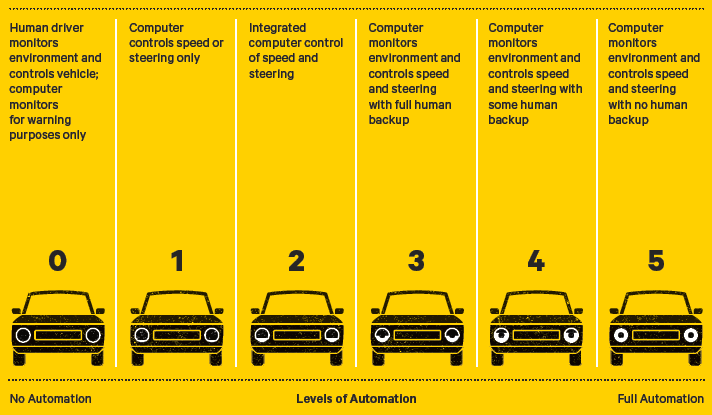Driverless cars are here. The question is how quickly they become mainstream
Milton Keynes is a UK town where many streets are reserved for pedestrians and bicycles. That made it a suitable place to test driverless cars, one of the great possibilities tied to the rise of artificial intelligence.
In what was declared a successful experiment, ‘pods’ with radar, lidar (that uses pulses of light to measure distance) and cameras feeding data into a central computer drove two passengers through the town during testing in 2016. (1)
Such testing is happening the world over as driverless driving represents one of the most-touted aspects of artificial intelligence. Almost every developed country including Australia is hosting pilot studies on automated vehicles. The big technology companies and the largest car companies are investing billions of dollars into driverless technology. Those investing hope to profit from a leap in transportation as significant as the bound from horses to cars was a century ago.
The promise of driverless vehicles is safer, faster, cheaper and more comfortable travel, especially for the disabled, the elderly and those who never learnt to drive. Robocars are poised to revolutionise travel within cities by promoting car sharing. Driverless proponents push the safety aspects the most because human error causes most of the world’s 1.25 million road deaths a year. (2)
The technological advances in automated driving are as impressive. The breakthrough to fully autonomous cars has been made, cars are including more autonomous features, robocars that require human backup are for sale, self-driving taxis (with a safety driver) have picked up passengers and automated driving with no safety driver has occurred on public roads. (3) Research firm IHS Automotive predicts the take-up of driverless cars to accelerate from 2030, such that 21 million robo-vehicles will be sold annually by 2035. (4) (In 2016, for context, about 92 million vehicles were sold worldwide.(5))
But driverless cars are some way from meeting the expectations of their biggest advocates. The largest obstacles to the mass uptake of driverless cars may prove to be challenges away from the technology. These issues include safety, legal and insurance liabilities, cybersecurity risks and making roads suitable. Above all this sits the unanswerable question of whether or not the public will feel safe being propelled at great speed by software. Enough people will surely be willing. Driverless vehicles are coming in some form. It might be years, however, before robo-vehicles appear in enough numbers to challenge the road share of the world’s 1 billion conventional cars and trucks.(6)
Attaining ‘level 5’
The Milton Keynes pods and other robocars would fit on the lowest levels of the global J3016 six-level spectrum of automated driving, as defined in 2014 by SAE International, a global association of engineers.(7)
From levels 0 to 2, a human dominates. On level 0, the driver does all. On level 1, a computer controls the speed or steering. At level 2, the software controls the steering and speed of the car. With levels 3 to 5, software dominates. At level 3, a computer monitors the vicinity to control the speed and steering of the car but full human backup is required. At level 4, the human stand-by is partial. At level 5, no human fall-back is required. The software does all. Vehicles categorised at levels 4 and 5 are considered ‘self-driving’. The most advanced driverless car for sale in 2017 is the Audi A8, which registers at level 3.(8)
The concept of how driverless cars work is straightforward; they use wireless technology to see the road ahead and move there safely. To enable autonomous vehicles to do that, roads need to be pre-mapped, signage and road markings made more visible and devices that communicate with car technology installed (and maintained) on roads. The digital maps mark the permanent features on roads such as lane markings, kerbs and street signs, and note speed limits and traffic controls.
Having a grasp of the fixed features ahead and confirmation of them from the road-based devices, robocars use global positioning technology, radar, lidar lasers, cameras and laser sensors to cope with fleeting items. The central computer analyses the incoming data to steer, accelerate, brake and signal the intentions of the vehicle, no matter the weather, light conditions and threats.
The spectrum of automated driving

Source: The Aspen Institute. “Taming the autonomous vehicle. A primer for cities.” 2017
The promise of robocars
The rise of autonomous driving could herald the advent of massive disruption of transport. US think tank, RethinkX, says that by 2030 about 95% of distance travelled in the US is likely to be in self-driving shared (electric) vehicles. (9)
Summoning (electric) robo-taxis by mobile will save US families US$1 trillion in transport costs a year, RethinkX says. Such a saving would trigger a major shift in consumer-spending patterns, while upending industries such as auto sales, car repairs, motels, truck haulage, fast-food outlets that rely on drive-throughs and car servicing.
While many jobs might become redundant, others will be created. People will want to make use of their time. An Intel-backed study forecasts that autonomous cars will create a “passenger economy” worth US$7 trillion by 2050 as pilotless vehicles free more than 250 million hours of time in the world’s most congested cities and save more than 585,000 lives from 2035 to 2045. (10) Instead of driving, people will dine, read, watch TV, use devices, even sleep.
Autonomous driving promises more fluid traffic. Computer simulations show that cars could travel closer together, speed through intersections faster, face fewer traffic jams and suffer fewer accident-caused delays. A University of California study says that toll roads might be able to double their traffic capacity from about 2,200 vehicles per lane per hour, much to the benefit of toll-road operators. (11) But less congestion only encourages people to use cars.
Tech snags
While the possibilities that automated vehicles herald are great, so too are the challenges. The infrastructure needed will be expensive and involve public money, which will make it political. (12) Signs, pavements and road markings will need to be made more visible and sensor-friendly and short-range communication devices must be installed. (13) Much pre-mapping needs to be done. Another technical challenge is eradicating glitches that could immobilise robocars or annoy users.
On top of this, there are hard-to-surmount quirks. The small size, speed and different shapes of bicycles confuses self-driving software as does cyclists to-and-froing at lights. (14) Volvo says the hopping of kangaroos bewilders its animal-detection system. (15) Another challenge is how robocars will deal with erratic human drivers, including pranksters who force them to stop.
A big hurdle for the driverless industry is getting laws changed so robocars can be driven on public roads. It’s tricky to legislate and test the safety of a concept. Lawmakers someday will have to decide whether or not to allow a vehicle to have no potential driver.
Dealing with collisions will prove tricky because it might be hard to judge who might be at fault, especially if two driverless cars crash. Lawmakers need to understand what ethical decisions coders have pre-programmed – the software is likely to favour the safety of a car’s passengers over pedestrians and people in other cars.
To promote the driverless industry, advocates are pushing the greatest promise of autonomous cars; fewer accidents, fewer deaths and fewer injuries. Fatalities, however, will still occur. A self-driving Tesla car killed its safety driver in 2016 when neither the driver nor the software spotted the trailer behind a truck crossing its path. (16)
While the road death toll is too high, looked at another way – by deaths per million vehicle kilometres driven – perhaps, cars don’t look as lethal. In Australia in 2014, there were 0.48 deaths per million vehicle kilometres travelled. The vested interest pushing driverless cars will need to prove they can lower this ratio.
Ultimately, the public must be willing to ride in driverless vehicles. Surveys suggest the public are wary. A London School of Economics study in 2010 found only 25% of the 12,000 people from 11 European countries asked were ‘comfortable’ with the idea of robocars. (17) A study in 2016 by the Humboldt University of Berlin found that 62% of respondents would “not want to hand over the complete vehicle operation”. (18)
Other issues determining public acceptance of driverless cars will be their affordability and how easy they are to operate. Time will tell how human drivers interact with driverless cars. Some say that erratic driving by humans could lead to segregated highways. Others worry that people’s driving skills may atrophy and they won’t react fast enough in emergencies.
Those testing robocars in Milton Keynes and the rest of the world have much to solve before a driverless world eventuates.
For further insights from Magellan please visit our website
By Michael Collins, Investment Specialist
(1) New Scientist. “First UK trial of driverless pods paves way for autonomous taxis.” 13 October 2016. (VIEW LINK)
(2) World Health Organisation. “Road traffic deaths.” The toll is for 2013, the latest year for which it is available. (VIEW LINK)
(3) Legally blind US citizen Steve Mahan rode solo in a Waymo car in Austin, Texas in 2016. “Google’s self-driving car unit became Waymo.” 13 December 2013. (VIEW LINK)
(4) HIS Automative. “Autonomous vehicle sales forecast to reach 21 mil globally in 2035, according to HIS Autormative.” 6 July 2016. (VIEW LINK)
(5) HIS Markit. “Global auto sales set to reach 93.5 million in 2017, but risk is greater than ever, HIS Markit says.” 21 February 2017. (VIEW LINK)
(6) The Aspen Institute. “Taming the autonomous vehicle. A primer for cities.” March 2017. Page 6 (VIEW LINK)
(7) SAE International. “Automated driving. Levels of driving automation are defined in new SAE International standard J3016.” (VIEW LINK) or (VIEW LINK)
(8) CAR magazine (of the UK). “How did Audi make the first car with level 3 autonomy?” 12 July 2017. (VIEW LINK)
(9) RethinkX. “Rethinking transportation 2020-2030.” May 2017. (VIEW LINK)
(10) Intel-sponsored report. StrategyAnalytics. “Accelerating the future: The economic impact of the emerging passenger economy.” June 21017. Pages 5 and 6. (VIEW LINK)
(11) Lewis Center. “Getting ready for the rise of autonomous vehicles.” UCLA Luskin School of Public Affairs. 2016. (VIEW LINK)
(12) Australia’s federal government, for starters, is investing $12 million to test positioning technology, namely satellite-based augmentation systems (that will benefit not just robocars). Australian government. Minister for resources and northern Australia. “$12 million boost for positioning technology in Australia.” 12 January 2017. (VIEW LINK)
(13) WIRED “Driverless cars need just one thing: futuristic roads.” 10 October 2016. (VIEW LINK)
(14) IEEE Spectrum. “The self-driving car’s bicycle problem.” 31 January 2017. (VIEW LINK)
(15) The Guardian. “Volvo admits its self-driving cars are confused by kangaroos.” 1 July 2017. (VIEW LINK)
(16) Financial Times. “Tesla reveals first self-driving car death.” 1 July 2016. (VIEW LINK)
(17)London School of Economics. “Thinkgoodmobility. Autonomous vehicles – negotiating a place on the road.” 2010. (VIEW LINK)
(18) Humboldt University of Berlin. “User perspectives on autonomous driving. A use-case-driven study in Germany.” 2016. Page 40. (VIEW LINK)
2 topics

